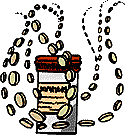 | Barbiturates |
 |
 | Barbiturates |
 |
What are Barbiturates?The hustle and bustle of everyday life creates stress in many people. To reduce stress, some people turn to drugs to bring back a feeling of calm. Alcohol is one drug people use to deal with stress; another class of drugs is called the "barbiturates." These drugs act to depress the central nervous system and are often called sleeping pills.The first barbiturates were made in the 1860s by the Bayer laboratories in Germany. In 1903, the first barbiturate ("barbital") was used in medical practices. In 1912, a common barbiturate, Phenobarbital, was introduced.
Barbiturates have been used extensively in the past as sedatives. A new group of drugs called "benzodiazepines" has replaced many of the barbiturates. However, barbiturates are still used to treat some types of epilepsy. |  Barbiturates Image courtesy of the Indiana Prevention Resource Center |
 Barbiturates Image courtesy of the Indiana Prevention Resource Center |
Behavioral Effects of BarbituratesBarbiturates have several effects on behavior depending on the dose:In low doses: barbiturates reduce anxiety; reduce respiration, reduce blood pressure, reduce heart rate and reduce rapid eye movement (REM)sleep. In higher doses: barbiturates can actually increase some types of behavior and act like a stimulant. These effects may be caused by depression of inhibitory brain circuits. In other words, barbiturates at these doses act to remove inhibitory behavior. Barbiturates can lead to excessive sedation and cause anesthesia, coma and even death. Barbiturate overdoses may occur because the effective dose of the drug is not too far away from the lethal dose. A major problem with barbiturates is that they may lead to tolerance and dependence. Tolerance occurs when a greater and greater amount of the drug is required to get the desired effect. For example, if barbiturates are used to help a person sleep, over time, a greater dose of the drug will be needed to get the person to sleep. Dependence occurs when a person feels like he or she must use the drug and withdrawal symptoms occur when the person stops using the drug.
|
Effects of Barbiturates on the BrainBarbiturates dissolve easily in fat. Therefore, barbiturates have ready access to the brain because they can cross the blood brain barrier easily. Also, because barbiturates dissolve into body fat, they can accumulate and re-enter the blood stream later. Different barbiturates clear out of the blood stream at different
rates.
Different barbiturates clear out of the blood stream at different
rates.Although the exact mechanisms by which barbiturates affect the brain are not understood, it is thought that these drugs bind to sodium channels on neurons and prevent the flow of sodium ions. Because sodium ions cannot flow across the neuronal membrane, action potentials cannot be produced. Barbiturates may also increase the flow of chloride ions across the neuronal membrane. This may occur through binding to the receptor for the neurotransmitter called GABA. The increased chloride ion flow reduces the chance that an action potential will be generated. |
Did you know? |
|
 For more
information about barbiturates, see: For more
information about barbiturates, see: |
| GO TO: | Alcohol | Amphetamines | Caffeine | Cocaine |
| Heroin | Inhalants | LSD | Marijuana | |
| Nicotine | Ecstasy | Rohypnol | 1,4-Butanediol | |
| GHB | Barbiturates | PCP | Hallucinogenic Mushrooms | |
| BACK TO: | Drug Effects
on the Nervous System |
Exploring the Nervous System | Table of Contents |
![[email]](./gif/menue.gif) Send E-mail |
 Get Newsletter |
 Search Pages |
 Donate to Neuroscience for Kids |